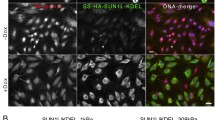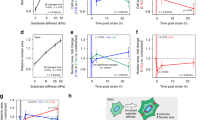Abstract
The nucleus is mechanically coupled to the three cytoskeletal elements in the cell via linkages maintained by the LINC complex (for Linker of Nucleoskeleton to Cytoskeleton). It has been shown that mechanical forces from the extracellular matrix (ECM) can be transmitted through the cytoskeleton to the nuclear surface. Here we quantified nuclear shape in NIH 3T3 fibroblasts on polyacrylamide gels with a controlled degree of cross-linking. On soft substrates with a Young’s modulus of 0.4 kPa, the nucleus appeared rounded in its vertical cross-section, while on stiff substrates (308 kPa), the nucleus appears more flattened. Over-expression of dominant negative Klarsicht ANC-1 Syne Homology (KASH) domains, which disrupts the LINC complex, eliminated the sensitivity of nuclear shape to substrate rigidity; myosin inhibition had similar effects. GFP-KASH4 over-expression altered the rigidity dependence of cell motility and cell spreading. Taken together, our results suggest that nuclear shape is modulated by substrate rigidity-induced changes in actomyosin tension, and that a mechanically integrated nucleus-cytoskeleton is required for rigidity sensing. These results are significant because they suggest that substrate rigidity can potentially control nuclear function and hence cell function.




Similar content being viewed by others
References
Ben-Ze’ev, A., S. R. Farmer, and S. Penman. Protein synthesis requires cell-surface contact while nuclear events respond to cell shape in anchorage-dependent fibroblasts. Cell 21(2):365–372, 1980.
Bissell, M. J., and J. Aggeler. Dynamic reciprocity: how do extracellular matrix and hormones direct gene expression? Prog. Clin. Biol. Res. 249:251–262, 1987.
Bissell, M. J., and M. H. Barcellos-Hoff. The influence of extracellular matrix on gene expression: is structure the message? J. Cell Sci. Suppl. 8:327–343, 1987.
Bissell, M. J., H. G. Hall, and G. Parry. How does the extracellular matrix direct gene expression? J. Theor. Biol. 99(1):31–68, 1982.
Boudou, T., et al. An extended relationship for the characterization of Young’s modulus and Poisson’s ratio of tunable polyacrylamide gels. Biorheology 43(6):721–728, 2006.
Bray, M. A., et al. Nuclear morphology and deformation in engineered cardiac myocytes and tissues. Biomaterials 31(19):5143–5150, 2010.
Brosig, M., et al. Interfering with the connection between the nucleus and the cytoskeleton affects nuclear rotation, mechanotransduction and myogenesis. Int. J. Biochem. Cell Biol. 42(10):1717–1728, 2010.
Burke, B., and K. J. Roux. Nuclei take a position: managing nuclear location. Dev. Cell 17(5):587–597, 2009.
Buxboim, A., et al. How deeply cells feel: methods for thin gels. J. Phys. Condens. Matter. 22(19):194116.
Buxboim, A., I. L. Ivanovska, and D. E. Discher. Matrix elasticity, cytoskeletal forces and physics of the nucleus: how deeply do cells ‘feel’ outside and in? J. Cell Sci. 123(Pt 3):297–308, 2010.
Chancellor, T. J., et al. Actomyosin tension exerted on the nucleus through nesprin-1 connections influences endothelial cell adhesion, migration, and cyclic strain-induced reorientation. Biophys. J . 99(1):115–123, 2010.
Chen, C. S., et al. Geometric control of cell life and death. Science 276(5317):1425–1428, 1997.
Chiu, J. J., S. Usami, and S. Chien. Vascular endothelial responses to altered shear stress: pathologic implications for atherosclerosis. Ann. Med. 41(1):19–28, 2009.
Crisp, M., et al. Coupling of the nucleus and cytoplasm: role of the LINC complex. J. Cell Biol. 172(1):41–53, 2006.
Discher, D. E., P. Janmey, and Y. L. Wang. Tissue cells feel and respond to the stiffness of their substrate. Science 310(5751):1139–1143, 2005.
Engler, A. J., et al. Myotubes differentiate optimally on substrates with tissue-like stiffness: pathological implications for soft or stiff microenvironments. J. Cell Biol. 166(6):877–887, 2004.
Engler, A. J., et al. Matrix elasticity directs stem cell lineage specification. Cell 126(4):677–689, 2006.
Farmer, S. R., et al. Regulation of actin mRNA levels and translation responds to changes in cell configuration. Mol. Cell. Biol. 3(2):182–189, 1983.
Fereol, S., et al. Prestress and adhesion site dynamics control cell sensitivity to extracellular stiffness. Biophys. J. 96(5):2009–2022, 2009.
Fischer-Vize, J. A., and K. L. Mosley. Marbles mutants: uncoupling cell determination and nuclear migration in the developing Drosophila eye. Development 120(9):2609–2618, 1994.
Georges, P. C., and P. A. Janmey. Cell type-specific response to growth on soft materials. J. Appl. Physiol. 98(4):1547–1553, 2005.
Ghibaudo, M., A. Saez, L. Trichet, A. Xayaphoummine, J. Browaeys, P. Silberzan, A. Buguin, and B. Ladoux. Traction forces and rigidity sensing regulate cell functions. Soft Matter 4:1836–1843, 2008.
Goeckeler, Z. M., P. C. Bridgman, and R. B. Wysolmerski. Nonmuscle myosin II is responsible for maintaining endothelial cell basal tone and stress fiber integrity. Am. J. Physiol. Cell Physiol. 295(4):C994–C1006, 2008.
Hague, F., D. Lloyd, D. T. Smallwood, C. L. Dent, C. Shanahan, A. Fry, R. Trembath, and S. Shackleton. SUN1 interacts with nuclear lamin A and cytoplasmic nesprins to provide a physical connection between the nuclear lamina and the cytoskeleton. Mol. Cell Biol. 26(10):3738–3751, 2006.
Huang, N. F., and S. Li. Regulation of the matrix microenvironment for stem cell engineering and regenerative medicine. Ann. Biomed. Eng. 39(4):1201–1214, 2011.
Ingber, D. E., and I. Tensegrity. Cell structure and hierarchical systems biology. J. Cell Sci. 116(Pt 7):1157–1173, 2003.
Itano, N., et al. Cell spreading controls endoplasmic and nuclear calcium: a physical gene regulation pathway from the cell surface to the nucleus. Proc. Natl Acad. Sci. USA. 100(9):5181–5186, 2003.
Ketema, M., and A. Sonnenberg. Nesprin-3: a versatile connector between the nucleus and the cytoskeleton. Biochem. Soc. Trans. 39(6):1719–1724.
Khatau, S. B., et al. A perinuclear actin cap regulates nuclear shape. Proc. Natl Acad. Sci. USA. 106(45):19017–19022, 2009.
Kovacs, M., et al. Mechanism of blebbistatin inhibition of myosin II. J. Biol. Chem. 279(34):35557–35563, 2004.
Kuypers, L. C., et al. A procedure to determine the correct thickness of an object with confocal microscopy in case of refractive index mismatch. J. Microsc. 218(Pt 1):68–78, 2005.
Lele, T. P., et al. Mechanical forces alter zyxin unbinding kinetics within focal adhesions of living cells. J. Cell. Physiol. 207(1):187–194, 2006.
Lo, C. M., et al. Cell movement is guided by the rigidity of the substrate. Biophys. J . 79(1):144–152, 2000.
Lombardi, M. L., et al. The Interaction between Nesprins and Sun Proteins at the Nuclear Envelope Is Critical for Force Transmission between the Nucleus and Cytoskeleton. J. Biol. Chem. 286(30):26743–26753, 2011.
Luxton, G. W., et al. Linear arrays of nuclear envelope proteins harness retrograde actin flow for nuclear movement. Science 329(5994):956–959, 2010.
Malone, C. J., et al. UNC-84 localizes to the nuclear envelope and is required for nuclear migration and anchoring during C. elegans development. Development 126(14):3171–3181, 1999.
Maniotis, A. J., C. S. Chen, and D. E. Ingber. Demonstration of mechanical connections between integrins, cytoskeletal filaments, and nucleoplasm that stabilize nuclear structure. Proc. Natl Acad. Sci. USA. 94(3):849–854, 1997.
Mosley-Bishop, K. L., et al. Molecular analysis of the klarsicht gene and its role in nuclear migration within differentiating cells of the Drosophila eye. Curr. Biol. 9(21):1211–1220, 1999.
Nagayama, K., Y. Yahiro, and T. Matsumoto. Stress fibers stabilize the position of intranuclear DNA through mechanical connection with the nucleus in vascular smooth muscle cells. FEBS Lett. 585(24):3992–3997, 2011.
Pelham, R. J., Jr., and Y. Wang. Cell locomotion and focal adhesions are regulated by substrate flexibility. Proc. Natl Acad. Sci. USA. 94(25):13661–13665, 1997.
Peyton, S. R., and A. J. Putnam. Extracellular matrix rigidity governs smooth muscle cell motility in a biphasic fashion. J. Cell. Physiol. 204(1):198–209, 2005.
Reiter, T., S. Penman, and D. G. Capco. Shape-dependent regulation of cytoskeletal protein synthesis in anchorage-dependent and anchorage-independent cells. J. Cell Sci. 76:17–33, 1985.
Roux, K. J., et al. Nesprin 4 is an outer nuclear membrane protein that can induce kinesin-mediated cell polarization. Proc. Natl Acad. Sci. USA. 106(7):2194–2199, 2009.
Saez, A., et al. Is the mechanical activity of epithelial cells controlled by deformations or forces? Biophys. J. 89(6):L52–L54, 2005.
Schlunck, G., et al. Substrate rigidity modulates cell matrix interactions and protein expression in human trabecular meshwork cells. Invest. Ophthalmol. Vis. Sci. 49(1):262–269, 2008.
Seliktar, D., R. M. Nerem, and Z. S. Galis. Mechanical strain-stimulated remodeling of tissue-engineered blood vessel constructs. Tissue Eng. 9(4):657–666, 2003.
Sen, S., A. J. Engler, and D. E. Discher. Matrix strains induced by cells: Computing how far cells can feel. Cell. Mol. Bioeng. 2(1):39–48, 2009.
Sims, J. R., S. Karp, and D. E. Ingber. Altering the cellular mechanical force balance results in integrated changes in cell, cytoskeletal and nuclear shape. J. Cell Sci. 103(Pt 4):1215–1222, 1992.
Solon, J., et al. Fibroblast adaptation and stiffness matching to soft elastic substrates. Biophys. J . 93(12):4453–4461, 2007.
Starr, D. A., and H. N. Fridolfsson. Interactions between nuclei and the cytoskeleton are mediated by SUN-KASH nuclear-envelope bridges. Annu. Rev. Cell Dev. Biol. 26:421–444, 2010.
Starr, D. A., and M. Han. Role of ANC-1 in tethering nuclei to the actin cytoskeleton. Science 298(5592):406–409, 2002.
Stewart-Hutchinson, P. J., et al. Structural requirements for the assembly of LINC complexes and their function in cellular mechanical stiffness. Exp. Cell Res. 314(8):1892–1905, 2008.
Thomas, C. H., et al. Engineering gene expression and protein synthesis by modulation of nuclear shape. Proc. Natl Acad. Sci. USA. 99(4):1972–1977, 2002.
Towbin, B. D., P. Meister, and S. M. Gasser. The nuclear envelope–a scaffold for silencing? Curr. Opin. Genet. Dev. 19(2):180–186, 2009.
Trappmann, B., et al. Extracellular-matrix tethering regulates stem-cell fate. Nat. Mater. 11(7):642–649, 2012.
Tzur, Y. B., K. L. Wilson, and Y. Gruenbaum. SUN-domain proteins: ‘Velcro’ that links the nucleoskeleton to the cytoskeleton. Nat. Rev. Mol. Cell Biol. 7(10):782–788, 2006.
Ulrich, T. A., E. M. de Juan Pardo, and S. Kumar. The mechanical rigidity of the extracellular matrix regulates the structure, motility, and proliferation of glioma cells. Cancer Res. 69(10):4167–4174, 2009.
Wilhelmsen, K., et al. Nesprin-3, a novel outer nuclear membrane protein, associates with the cytoskeletal linker protein plectin. J. Cell Biol. 171(5):799–810, 2005.
Wittelsberger, S. C., K. Kleene, and S. Penman. Progressive loss of shape-responsive metabolic controls in cells with increasingly transformed phenotype. Cell 24(3):859–866, 1981.
Weng, S., and J. Fu. Synergistic regulation of cell function by matrix rigidity and adhesive pattern. Biomaterials 32(36):9584–93.
Simon, D. N., and K. L. Wilson. The nucleoskeleton as a genome-associated dynamic ‘network of networks’. Nat. Rev. Mol. Cell Biol. 12(11):695–708.
Zemel, A., et al. Optimal matrix rigidity for stress fiber polarization in stem cells. Nat. Phys. 6(6):468–473.
Fouchard, J., D. Mitrossilis, and A. Asnacios. Acto-myosin based response to stiffness and rigidity sensing. Cell Adh. Migr. 5(1):16–19.
Yen, A., and A. B. Pardee. Role of nuclear size in cell growth initiation. Science 204(4399):1315–1317, 1979.
Yeung, T., et al. Effects of substrate stiffness on cell morphology, cytoskeletal structure, and adhesion. Cell Motil. Cytoskeleton 60(1):24–34, 2005.
Zhang, J., et al. Nesprin 1 is critical for nuclear positioning and anchorage. Hum. Mol. Genet. 19(2):329–341, 2010.
Zhou, Z., et al. Structure of Sad1-UNC84 homology (SUN) domain defines features of molecular bridge in nuclear envelope. J. Biol. Chem. 287(8):5317–5326, 2011.
Acknowledgments
The authors gratefully acknowledge help from Lynn Combee, Craig Moneypenny and Neal Benson for helpful discussion and running FACS analysis, from Chris Gasser and Varun Aggarwal for help with confocal imaging, and from David Hays for help measuring gel thickness. This work was supported by the National Science Foundation under awards CMMI 0954302 (T.P.L.) and NIH R01 EB014869 (T.P.L.).
Conflict of interest
The authors have no conflicts of interest related to this paper.
Author information
Authors and Affiliations
Corresponding author
Additional information
Associate Editor Dennis Discher oversaw the review of this article.
Electronic supplementary material
Below is the link to the electronic supplementary material.
Rights and permissions
About this article
Cite this article
Lovett, D.B., Shekhar, N., Nickerson, J.A. et al. Modulation of Nuclear Shape by Substrate Rigidity. Cel. Mol. Bioeng. 6, 230–238 (2013). https://doi.org/10.1007/s12195-013-0270-2
Received:
Accepted:
Published:
Issue Date:
DOI: https://doi.org/10.1007/s12195-013-0270-2




